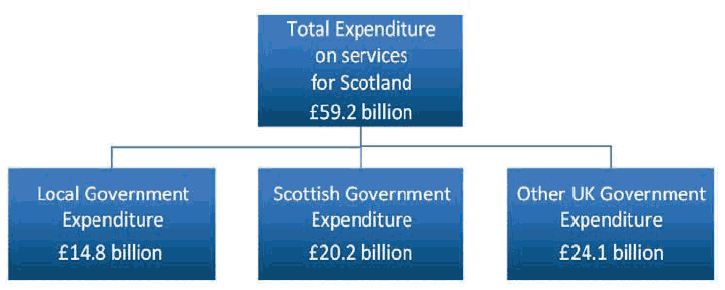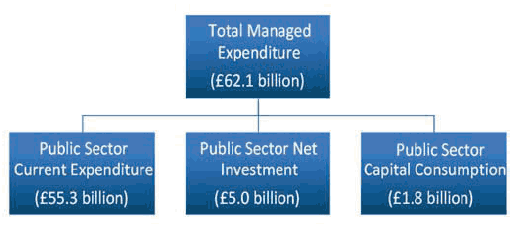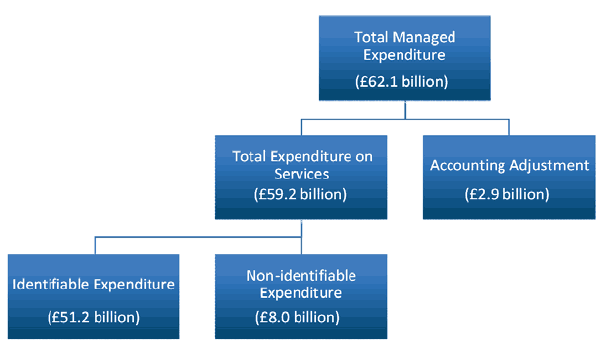Government Expenditure and Revenue Scotland 2009-2010
Government Expenditure and Revenue Scotland 2009-2010
2 FISCAL BACKGROUND
This chapter outlines the institutional framework in which Scottish public sector expenditure and revenue is currently set.
PUBLIC SECTOR EXPENDITURE FOR SCOTLAND
Total Managed Expenditure in the United Kingdom
In the current UK public finance framework, the key expenditure aggregate is Total Managed Expenditure ( TME) 9. TME comprises public sector current expenditure, net investment, and capital consumption. TME covers the entire public sector, including central government (Scottish Government and UK Government), local government, and public corporations.
System of Public Expenditure and Data Sources
The primary source of public sector expenditure data across the four countries of the UK is the Public Expenditure Statistical Analyses ( PESA) database published by HM Treasury. Expenditure figures in PESA are net expenditure ( e.g. expenditure net of any receipts).
Included in PESA is an analysis of Total Expenditure on Services ( TES) by country and region ( CRA). HM Treasury request that UK departments and devolved administrations apportion spending between countries and regions on the basis of 'who benefits', using the for methodology. Guidance on how this should be done is provided by HM Treasury and ONS. HM Treasury then collates departments' returns and combines these with the known spending of local authorities. The results for 2005-06 to 2009-10 are published in Chapters 9 and 10 of PESA.
The data in PESA and CRA are presented according to the Classification of the Functions of Government ( COFOG), a United Nations based code for functional analysis of government expenditure 10.
It is important to note that expenditure allocated to Scotland in PESA includes expenditure by the Scottish Government, expenditure by Scottish local authorities, expenditure by public corporations for Scotland and expenditure by the UK Government on goods and services for the benefit of Scotland, as summarised in Figure 2.1.
In this context, the term 'central government' comprises: parliaments; government departments and their executive agencies; government funds such as the national loans fund; the official foreign exchange reserves; non-departmental public bodies; NHS trusts and various other non-market public bodies controlled by the public sector. Central government does not include some non-profit institutions that receive significant government funding, but are not controlled by government. These are classified in the private or third sector: for example, universities, further education colleges, and housing associations.
Local government comprises all local government administrations in the UK. Scotland has 32 local authorities operating over the period of this edition of GERS.
Public corporations are publicly controlled entities that are deemed to operate in the market based on a test of their sales to operating costs. A body that fails this test, such as the BBC where the majority of its income is from the licence fee rather than sales, is deemed non-market and will hence be classified as either central or local government.
Figure 2.1 - Total Public Sector Expenditure for Scotland: 2009-10

A number of significant improvements have been made to the PESACRA database in recent years to apportion expenditure more accurately to countries and regions. While many anomalies in previous editions of PESACRA have been addressed and are now reflected in both PESACRA 2011 and this GERS report, a small number of supplementary amendments to the PESACRA 2011 dataset were made in producing this GERS. The aim of these refinements was to ensure that the public sector expenditure figure for Scotland captures as accurately as possible expenditure for the benefit of Scotland. As part of the preparation of GERS, Scottish Government statisticians have scrutinised the published April 2011 PESACRA data to identify any remaining issues. From 1,400 programme object groups in PESACRA 2011, a small number were identified and, in these cases, GERS uses different data to those in the underlying PESACRA database. All such amendments are set out in Chapter 6 and Appendix B.
Although every effort has been made when compiling this report to verify the credibility and accuracy of the data contained in PESA, work to improve the quality of PESA is an ongoing objective of HM Treasury and UK Government departments. Scottish Government officials will continue to liaise with UK Government colleagues to improve further the quality of the PESA data.
The Framework for the Management of Expenditure by the Scottish Government
Scottish Government spending programmes fall into two categories: those within the Scottish Departmental Expenditure Limit ( DEL) and those within Annually Managed Expenditure ( AME), as set out in Box 2.1.
- Departmental Expenditure Limit ( DEL) expenditure is expenditure that is planned and controlled across the period of each spending review; and,
- Annually Managed Expenditure ( AME) is expenditure that cannot reasonably be subject to firm, multi-year limits in the same way as DEL.
DEL is significantly larger than AME. DEL plus AME plus an 'accounting adjustment' sum to TME.
The Scottish Government's DEL encompasses most administrative budgets and all programme expenditures. Programmes outside the Scottish Government's DEL are mainly those where expenditure cannot be planned far ahead and has to be adjusted annually; for example, expenditure on the capital costs relating to motorways and trunk roads.
For programmes within DEL, Scotland (like the other devolved administrations) receives a direct funding allocation from the UK Government. Expenditure limits are raised according to the population-related proportion of spending increases on comparable expenditure by Whitehall departments (this process is known as the "Barnett Formula"). For the years contained within this publication, such expenditure has, by and large, been determined by the UK Government as part of the UK Comprehensive Spending Review process.
The Framework for the Management of Expenditure for Scotland by the UK Government
UK Government expenditure for Scotland falls into the same two categories: DEL and AME. This expenditure is governed by the same rules and accounting procedures as those for the Scottish Government.
The single largest element of identifiable public sector expenditure for Scotland by a Whitehall Department is social security expenditure, which is administered by the Department for Work and Pensions ( DWP).
The Framework for the Management of Local Government Expenditure for Scotland
Scotland's local government 'net revenue expenditure' is supported through a combination of funding from central government, known as total revenue support, and resources raised locally by local authorities themselves through council tax. Total revenue support comprises three elements: the amount which Scottish Ministers have estimated will be payable to local authorities as specific revenue grants; the distributable amount of non-domestic rate income ( NDRI); and General Revenue Grant ( GRG). The total amount of revenue support is distributed to local authorities using an agreed needs-based methodology, known as the client group approach. Statistical data describing the 'clients' - i.e. those who 'benefit' from particular services - are used to re-distribute resources between local authorities in Scotland.
Capital expenditure by local government in Scotland is primarily funded by borrowing, the sale of surplus assets and central government grants. Grant support from the Scottish Government is in the form of specific capital grants to support individual projects or programmes, and a General Capital Grant ( GCG). Distribution of both reflects the needs of local authorities using a similar needs-based approach to the GRG. The GRG includes support to local authorities to meet some of the borrowing costs associated with their capital expenditure.
The Framework for the Management of Expenditure by Public Corporations for Scotland
Expenditure by public corporations for Scotland is set out within DEL and AME. Individual public corporations are responsible for their own expenditure. The largest public corporation in Scotland is Scottish Water. The expenditure incurred by public corporations in producing goods and services for sale is not included in public sector current expenditure. Instead, it is deducted from their sales and the net position is recorded in public sector revenue.
Box 2.1 - Aggregate Scottish Public Sector Expenditure
This box outlines the two key measures of aggregate public sector expenditure in UK public finances, Total Managed Expenditure ( TME) and Total Expenditure on Services ( TES), which are used in GERS. Total Managed Expenditure TME is an aggregate measure of public sector expenditure derived from the UK National Accounts. It encompasses all current and capital spending by the public sector and includes the activities of central and local governments and public corporations. In GERS, TME is the expenditure side of the equation used to derive Scotland's net fiscal balance. TME is comprised of a number of different sub measures. For example, TME can be broken down into public sector current expenditure, public sector net investment and public sector capital consumption, as set out in the chart below. Total Managed Expenditure, Scotland 2009-10
TME can also be expressed as the sum of Annually Managed Expenditure ( AME) and Departmental Expenditure Limits ( DEL). AME covers current and capital spending programmes which are generally less predictable and are not easily subject to firm multi-year limits. Key elements of AME include debt interest payments and social transfers such as tax credits and unemployment benefit. In contrast, DEL covers spending which is planned and controlled across the period of a spending review period and generally incorporates administrative budgets and all programme expenditures, such as most spending on health and education. The vast majority of expenditure by the Scottish Government is DEL expenditure. Total Expenditure on Services The detailed COFOG analysis of public sector expenditure in GERS ( Chapter 6) focuses on TES. TES is an alternative aggregate of public sector expenditure in the UK provided in PESA which can be used to analyse a detailed breakdown of public sector capital and current spending by government department. TES accounts for approximately 95% of TME and there are a number of minor differences between TES and TME. The main differences are that TES does not include general government capital consumption and does not reverse the deduction of certain VAT refunds from budget based expenditure data. TES also contains a number of items that are in departmental budgets but are not included in TME, for example the hidden benefit contained within student loans, which are granted with a concessional interest rate. An accounting adjustment reconciles TES and TME such that TES plus the accounting adjustment equals TME as summarised in the figure below. The accounting adjustment used in GERS is set out in more detail in Chapter 6. Total Managed Expenditure, Scotland 2009-10
|
PUBLIC SECTOR REVENUE IN SCOTLAND
UK Fiscal Revenues
The vast majority of fiscal revenue raised by the public sector in Scotland is controlled by the UK Government with collection the responsibility of HM Revenue and Customs. Changes to UK taxation are typically announced in the UK Budget. Taxes on income and wealth and on production are the two largest sources of tax revenue in the UK.
The primary source of UK revenue data is the ONS's Public Sector Finance statistics.
Devolved Fiscal Revenues
Under The Scotland Act 1998, the Scottish Parliament has the power to vary the UK basic rate of income tax by up to 3 pence for Scottish residents. To date, this power has not been used. For 2009-10, the potential change in revenue from the full use of this power was approximately £1 billion 11.
Local government 'own-source' revenues stem from council tax, non-domestic rates (also known as business rates) and non-tax revenues such as user charges, fees and fines. Council tax and non-tax revenues are controlled and administered by individual local authorities.
Since 1 April 1993, all non-domestic rates income ( NDRI) in Scotland has been placed in a national 'pool' and shared between local authorities pro rata to their population. Although the poundage rate is set nationally by the Scottish Government, local authorities are responsible for the local collection of NDRI.
Government Borrowing
The borrowing powers of the Scottish Government are strictly limited. The Scotland Act 1998 provides for short term borrowing sufficient to cover 'a temporary excess of sums paid out of the Scottish Consolidated Fund over sums paid into that Fund' or for 'providing a working balance in the Fund'. Any such borrowings must only be from the UK Government. In effect, this means that the Scottish Government has no authority to raise extra resource by borrowing or sanctioning borrowing except for in exceptional circumstances. Local authorities have wider borrowing powers. These are summarised in the Framework for Local Government expenditure section on page 17.
The UK Government is able to borrow to fund public sector expenditure across the UK, including the Scottish Government block grant.
There is a problem
Thanks for your feedback

